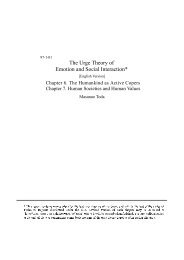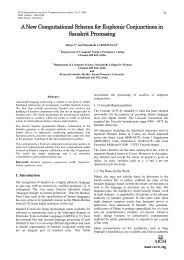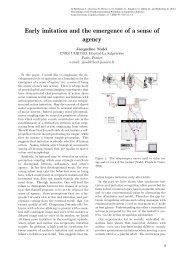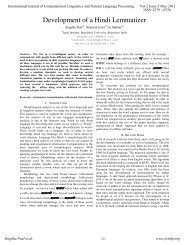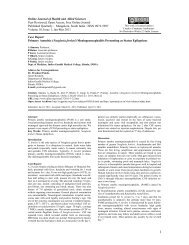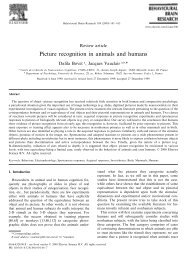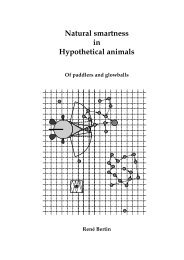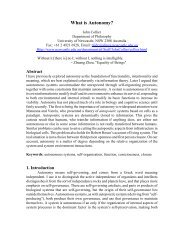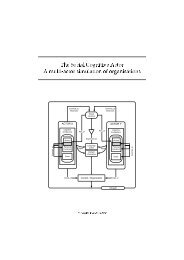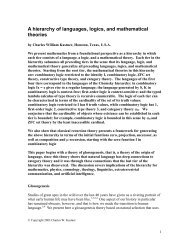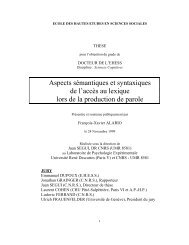Metzinger · Subjekt und Selbstmodell - Cogprints
Metzinger · Subjekt und Selbstmodell - Cogprints
Metzinger · Subjekt und Selbstmodell - Cogprints
Erfolgreiche ePaper selbst erstellen
Machen Sie aus Ihren PDF Publikationen ein blätterbares Flipbook mit unserer einzigartigen Google optimierten e-Paper Software.
Literaturverzeichnis 299<br />
Jackson, F. (1986). What Mary didn’t know. Journal of Philosophy, 83, 291 295.<br />
Jacobs, B.L. ⁄ Trulson, M.E. (1979). Mechanism of action of LSD. American Scientist, 67, 396 404.<br />
Johnson Laird, P.N. (1983). Mental models: towards a cognitive science of language, inference<br />
and consciousness. Cambridge University Press.<br />
Johnson Laird, P.N. (1988). A computational analysis of consciousness. In:Marcel⁄ Bisiach<br />
1988.<br />
Johnson Laird, P.N. (1989). Mental Models. In: Posner 1989.<br />
Katz, J.⁄ Melzack, R. (1990). Pain „Memories“ in Phantom Limbs: Review and Clinical<br />
Observations. Pain, 43 (3), 319 336.<br />
Kemmerling, A. (1991). Mentale Repräsentationen. Kognitionswissenschaft, 1, 47 57.<br />
Kennedy, M.B. (1989). Regulation of neuronal function by calcium. Trends in Neurosciences,<br />
12, 417 420.<br />
Kiefer, E. (1988). Metakognition, Introspektion <strong>und</strong> verbale Berichte über sich selbst.Unveröf<br />
fentlichte Dissertation.<br />
Kim, J. (1978). Supervenience and Nomological Incommensurables. American Philosophical<br />
Quarterly, 15, 149 156.<br />
Kim, J. (1979). Causality, Identity, and Supervenience in the Mind Body Problem. Midwest<br />
Studies in Philosophy, 4, 31 49.<br />
Kim, J. (1982). Psychophysical Supervenience as a Mind Body Theory. Cognition and Brain<br />
Theory, 5, 129 147.<br />
Kim, J. (1982). Psychophysical Supervenience. Philosophical Studies, 41, 51 70.<br />
Kim, J. (1984). Concepts of Supervenience. Philosophy and Phenomenological Research, 45,<br />
153 176.<br />
Kim, J. (1984). Epiphenomenal and Supervenient Causation. Midwest Studies in Philosophy,<br />
9, 257 270.<br />
Kim, J. (1984). Supervenience and Supervenient Causation. Southern Journal of Philosophy,<br />
22, Spindel Conference Supplement on Supervenience, 45 56.<br />
Kim, J. (1985). Supervenience, Determination and Reduction. Journal of Philosophy, 82, 616<br />
618.<br />
Kim, J. (1987). „Strong“ and „Global“ Supervenience Revisited. Philosophy and Phenomeno<br />
logical Research, Vol.XLVIII, 2, 315 326.<br />
Kim, J. (1989). The Myth of Nonreductive Materialism. Proceedings and Adresses of The<br />
American Philosophical Association, 63 (3), 31 47.<br />
Kim, J. (1990). Explanatory Exclusion and the Problem of Mental Causation. In: Villanueva<br />
(Ed) 1990.<br />
Kinsbourne, M. (1988). Integrated Field Theory of Consciousness. In:Marcel⁄ Bisiach1988.<br />
Kirk, R. (1974). Sentience and Behavior. Mind, 83, 43 60.<br />
Kitcher, P. (1984). In Defense of intentional Psychology. Journal of Philosophy, 81,89 106.<br />
Kosslyn, S.M. (1980). Image and Mind. Cambridge⁄ MA: Harvard University Press.<br />
Kosslyn, S.M. (1981). The medium and the message in mental imagery: A theory. Psychologi<br />
cal Review, 88, 46.<br />
Kosslyn, S.M. (1983). Ghosts in the Mind’s Machine. New York: Norton.<br />
Kosslyn, S.M.⁄ Shwartz, S.P. (1977). A simulation of visual imagery. Cognitive Science, 1, 265<br />
295.<br />
Krämer, S. (1993)[Hrsg.]. Geist, Gehirn, Künstliche Intelligenz Zeitgenössische Modelle des<br />
Denkens. Berlin, New York: de Gruyter.<br />
Kreiter, A. K.⁄ Singer, W. (1992). Oscillatory Neuronal Responses in the Visual Cortex of the<br />
Awake Macaque Monkey. European Journal of Neuroscience, Volume4,369 375.<br />
Kripke, S.A. (1971). Identity and Necessity. In: Munitz 1971.<br />
Kripke, S.A. (1972). Naming and Necessity. In: Davidson⁄ Harman 1972.<br />
Kukla, R. (1992). Cognitive Models and Representation. British Journal of Philosophy of<br />
Science, 43, 219 232.<br />
Kurthen, M. (1990). Das Problem des Bewußtseins in der Kognitionswissenschaft Perspekti<br />
ven einer „Kognitiven Neurowissenschaft“. Stuttgart: Enke.



